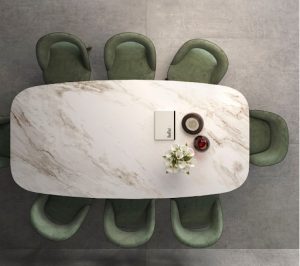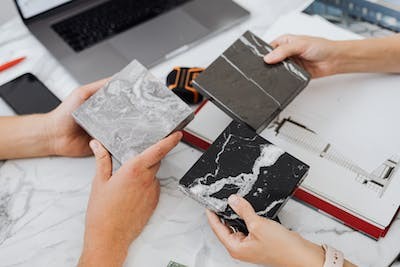

Marble is involved in our lives in countless spaces. Some of the most common examples are floors, walls and even kitchen countertops. As the specific requirements for each space have got more demanding, the interest in man-made stones substantially increased over the last decades. And those reasons are not avoidable!
Porcelain is intentionally created to resemble marble and thus, the materials can look similar. But what is the difference between the two? For starters, marble is naturally found in nature, while porcelain is created and manufactured with natural ingredients. Apart from their origins, do their features and characteristics differ? Which material is ideal to install in your space? Let’s explore these questions further to understand the difference between porcelain and marble.
Porcelain is a type of ceramic made from refined clay. It is glazed and baked at very high temperatures and pressures, which makes the material thick, less absorbent and highly durable. Additionally, as it is non-porous, it is less likely to stain.
Marble is a naturally found stone, generally grey or cream in colour with dark-coloured veins. To create a tile or slab from marble, the stone is sized and cut down, then polished and finished for a uniform surface. Furthermore, each and every tile design is different.
Porcelain tiles are rated on the PEI (Porcelain Enamel Institute) scale based on strength and durability. If the hardness rating is four or five, then it is considered the best surface, which is strong and highly durable. If the PEI rating is three or below, it is suitable for residences and spaces with light commercial traffic. Additionally, a rating of one can only be used for light footwear like socks and slippers, and zero means the surface isn’t suitable to be installed as floors.
Marble is suitable for any kind of foot traffic and is usually rated between three and five on the Mohs Hardness Scale. However, certain properties of marble would not allow them to be used as commonly as porcelain. For example, marble is more porous which allows higher water adsorption rates. This crates a major problem unless it is further processed to create additional coating to prevent those which can be costly.
Higher water adsorption rates of marbles results in the possibility to crack when water penetrates and expands its structure at cold climates. Considering relatively colder winter temperatures in Canada compared to many other countries, you may not want to use marble tiles or slabs as exterior cladding.
One of the major problems associated with the porous structure of marbles is staining. You may not care too much if your living room walls would get splashes of wine,but this could be a deal breaker for countertop or table-top applications.
Porcelain is a very strong and dense material, which is stain and heat resistant. Its unique and valuable features make it highly demanding, as it’s pretty easy to clean and maintain.On the other hand, marble would require extra care. You have to ensure to apply sealant frequently to prevent staining or discolouring. You would need extra care especially when it is used on countertop, coffee or dining table surfaces.
As bothmaterials are heavy, they can be difficult to install by an individual. Hiring a professional who would neatly and carefully install the tiles is always advised. Especially when applications with large-format use of marble or porcelain are required, you may need more than two people to handle the work.
The actual difference after installation may present itself for certain projects. Although both materials present beautiful patterns and colors, a seamless effect of veining can only be achieved by porcelain products. Marble is a natural material and do not provide with the flexibility to present a continuous affect especially in large format applications. On the other hand, porcelain has book-match and end-match options and even endless-loops for larger wall and flooring projects.
Northern Lights Porcelain has spectacular collection of porcelain products with a generous variety of color and pattern options in book-match and end-match configurations. Transform your residence into the space of your dreams by incorporating Northern Lights Porcelain slabs. To learn more about our products, call us today.
© 2022 Northern Lights Porcelain. All Rights Reserved. Marketing and Design by Rapid Boost Marketing.